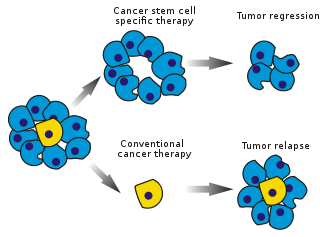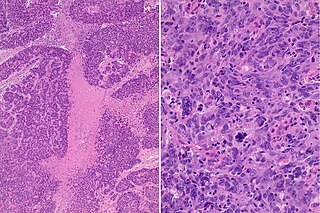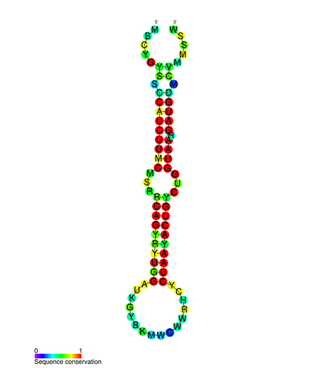Related Research Articles

Metastasis is a pathogenic agent's spread from an initial or primary site to a different or secondary site within the host's body; the term is typically used when referring to metastasis by a cancerous tumor. The newly pathological sites, then, are metastases (mets). It is generally distinguished from cancer invasion, which is the direct extension and penetration by cancer cells into neighboring tissues.
Autocrine signaling is a form of cell signaling in which a cell secretes a hormone or chemical messenger that binds to autocrine receptors on that same cell, leading to changes in the cell. This can be contrasted with paracrine signaling, intracrine signaling, or classical endocrine signaling.

Cancer stem cells (CSCs) are cancer cells that possess characteristics associated with normal stem cells, specifically the ability to give rise to all cell types found in a particular cancer sample. CSCs are therefore tumorigenic (tumor-forming), perhaps in contrast to other non-tumorigenic cancer cells. CSCs may generate tumors through the stem cell processes of self-renewal and differentiation into multiple cell types. Such cells are hypothesized to persist in tumors as a distinct population and cause relapse and metastasis by giving rise to new tumors. Therefore, development of specific therapies targeted at CSCs holds hope for improvement of survival and quality of life of cancer patients, especially for patients with metastatic disease.
The epithelial–mesenchymal transition (EMT) is a process by which epithelial cells lose their cell polarity and cell–cell adhesion, and gain migratory and invasive properties to become mesenchymal stem cells; these are multipotent stromal cells that can differentiate into a variety of cell types. EMT is essential for numerous developmental processes including mesoderm formation and neural tube formation. EMT has also been shown to occur in wound healing, in organ fibrosis and in the initiation of metastasis in cancer progression.
Anoikis is a form of programmed cell death that occurs in anchorage-dependent cells when they detach from the surrounding extracellular matrix (ECM). Usually cells stay close to the tissue to which they belong since the communication between proximal cells as well as between cells and ECM provide essential signals for growth or survival. When cells are detached from the ECM, there is a loss of normal cell–matrix interactions, and they may undergo anoikis. However, metastatic tumor cells may escape from anoikis and invade other organs.
Intravasation is the invasion of cancer cells through the basement membrane into a blood or lymphatic vessel. Intravasation is one of several carcinogenic events that initiate the escape of cancerous cells from their primary sites. Other mechanisms include invasion through basement membranes, extravasation, and colonization of distant metastatic sites. Cancer cell chemotaxis also relies on this migratory behavior to arrive at a secondary destination designated for cancer cell colonization.

Proline-, glutamic acid- and leucine-rich protein 1 (PELP1) also known as modulator of non-genomic activity of estrogen receptor (MNAR) and transcription factor HMX3 is a protein that in humans is encoded by the PELP1 gene. is a transcriptional corepressor for nuclear receptors such as glucocorticoid receptors and a coactivator for estrogen receptors.

CD146 also known as the melanoma cell adhesion molecule (MCAM) or cell surface glycoprotein MUC18, is a 113kDa cell adhesion molecule currently used as a marker for endothelial cell lineage. In humans, the CD146 protein is encoded by the MCAM gene.

Metastasis-associated protein MTA1 is a protein that in humans is encoded by the MTA1 gene. MTA1 is the founding member of the MTA family of genes. MTA1 is primarily localized in the nucleus but also found to be distributed in the extra-nuclear compartments. MTA1 is a component of several chromatin remodeling complexes including the nucleosome remodeling and deacetylation complex (NuRD). MTA1 regulates gene expression by functioning as a coregulator to integrate DNA-interacting factors to gene activity. MTA1 participates in physiological functions in the normal and cancer cells. MTA1 is one of the most upregulated proteins in human cancer and associates with cancer progression, aggressive phenotypes, and poor prognosis of cancer patients.

Disintegrin and metalloproteinase domain-containing protein 15 is an enzyme that in humans is encoded by the ADAM15 gene.

The basal-like carcinoma is a recently proposed subtype of breast cancer defined by its gene expression and protein expression profile.

Forkhead box protein M1 is a protein that in humans is encoded by the FOXM1 gene. The protein encoded by this gene is a member of the FOX family of transcription factors. Its potential as a target for future cancer treatments led to it being designated the 2010 Molecule of the Year.

Cadherin-1 or Epithelial cadherin(E-cadherin), is a protein that in humans is encoded by the CDH1 gene. Mutations are correlated with gastric, breast, colorectal, thyroid, and ovarian cancers. CDH1 has also been designated as CD324. It is a tumor suppressor gene.

Eribulin, sold under the brand name Halaven among others, is an anti-cancer medication used to treat breast cancer and liposarcoma.

In molecular biology, the miR-200 microRNA is a short RNA molecule. MicroRNAs function to regulate the expression levels of other genes by binding and cleaving mRNAs or inhibiting translation. The miR-200 family contains miR-200a, miR-200b, miR-200c, miR-141, and miR-429. There is growing evidence to suggest that miR-200 microRNAs are involved in cancer metastasis.

In molecular biology miR-205 microRNA is a short RNA molecule. MicroRNAs function to regulate the expression levels of other genes by several mechanisms. They are involved in numerous cellular processes, including development, proliferation, and apoptosis. Currently, it is believed that miRNAs elicit their effect by silencing the expression of target genes.
Migration inducting gene 7 is a gene that corresponds to a cysteine-rich protein localized to the cell membrane and cytoplasm. It is the first-in-class of novel proteins translated from what are thought to be long Non-coding RNAs.
Patient derived xenografts (PDX) are models of cancer where the tissue or cells from a patient's tumor are implanted into an immunodeficient or humanized mouse. It is a form of xenotransplantation. PDX models are used to create an environment that allows for the continued growth of cancer after its removal from a patient. In this way, tumor growth can be monitored in the laboratory, including in response to potential therapeutic options. Cohorts of PDX models can be used to determine the therapeutic efficiency of a therapy against particular types of cancer, or a PDX model from a specific patient can be tested against a range of therapies in a 'personalized oncology' approach.
Breast cancer metastatic mouse models are experimental approaches in which mice are genetically manipulated to develop a mammary tumor leading to distant focal lesions of mammary epithelium created by metastasis. Mammary cancers in mice can be caused by genetic mutations that have been identified in human cancer. This means models can be generated based upon molecular lesions consistent with the human disease.
Evolutionary therapy is a subfield of evolutionary medicine that utilizes concepts from evolutionary biology in management of diseases caused by evolving entities such as cancer and microbial infections. These evolving disease agents adapt to selective pressure introduced by treatment, allowing them to develop resistance to therapy, making it ineffective.
References
- Yoon, JR; Whipple, RA; Balzer, EM; Cho, EH; Matrone, MA; Peckham, M; Martin, SS (Oct 2011). "Local anesthetics inhibit kinesin motility and microtentacle protrusions in human epithelial and breast tumor cells". Breast Cancer Res Treat. 129 (3): 691–701. doi:10.1007/s10549-010-1239-7. PMC 4232214 . PMID 21069453.
- Balzer, EM; Whipple, RA; Thompson, K; Boggs, AE; Slovic, J; Cho, EH; Matrone, MA; Yoneda, T; Mueller, SC; Martin, SS (Dec 2010). "c-Src differentially regulates the functions of microtentacles and invadopodia". Oncogene. 29 (48): 6402–8. doi:10.1038/onc.2010.360. PMC 4073667 . PMID 20956943.
- Matrone, MA; Whipple, RA; Balzer, EM; Martin, SS (Oct 2010). "Microtentacles tip the balance of cytoskeletal forces in circulating tumor cells". Cancer Res. 70 (20): 7737–41. doi:10.1158/0008-5472.CAN-10-1569. PMC 4232206 . PMID 20924109.
- Whipple, RA; Matrone, MA; Cho, EH; Balzer, EM; Vitolo, MI; Yoon, JR; Ioffe, OB; Tuttle, KC; Yang, J; Martin, SS (Oct 2010). "Epithelial-to-mesenchymal transition promotes tubulin detyrosination and microtentacles that enhance endothelial engagement". Cancer Res. 70 (20): 8127–37. doi:10.1158/0008-5472.CAN-09-4613. PMC 3123454 . PMID 20924103.
- Matrone, MA; Whipple, RA; Thompson, K; Cho, EH; Vitolo, MI; Balzer, EM; Yoon, JR; Ioffe, OB; Tuttle, KC; Tan, M; Martin, SS (Jun 2010). "Metastatic breast tumors express increased tau, which promotes microtentacle formation and the reattachment of detached breast tumor cells". Oncogene. 29 (22): 3217–27. doi:10.1038/onc.2010.68. PMC 3132415 . PMID 20228842.
- Balzer, EM; Whipple, RA; Cho, EH; Matrone, MA; Martin, SS (May 2010). "Antimitotic chemotherapeutics promote adhesive responses in detached and circulating tumor cells". Breast Cancer Res Treat. 121 (1): 65–78. doi:10.1007/s10549-009-0457-3. PMC 3633461 . PMID 19593636.
- Whipple, R.A.; Balzer, E.M.; Cho, E.H; Matrone, M.A; Yoon, J.R.; Martin, S.S. (2008). "Vimentin Filaments Support Extension of Tubulin-Based Microtentacles in Detached Breast Tumor Cells". Cancer Research. 68 (14): 5678–5688. doi:10.1158/0008-5472.CAN-07-6589. PMC 2859318 . PMID 18632620.
- Whipple, R.A.; Cheung, A.M.; Martin, S.S. (2007). "Detyrosinated microtubule protrusions in suspended mammary epithelial cells promote reattachment". Experimental Cell Research. 313 (7): 1326–36. doi:10.1016/j.yexcr.2007.02.001. PMC 3132414 . PMID 17359970.